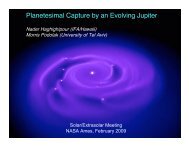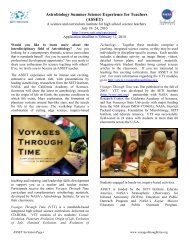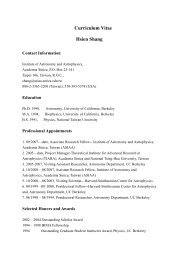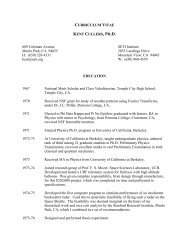SETI Institute Frequently Asked Questions To help you quickly find ...
SETI Institute Frequently Asked Questions To help you quickly find ...
SETI Institute Frequently Asked Questions To help you quickly find ...
- No tags were found...
You also want an ePaper? Increase the reach of your titles
YUMPU automatically turns print PDFs into web optimized ePapers that Google loves.
Why do <strong>you</strong> think ET will broadcast in the microwave<br />
frequency band<br />
There is relatively little background static from galaxies,<br />
quasars, and other cosmic noisemakers in the<br />
microwave part of the spectrum. This makes faint<br />
signals easier to pick out. Additionally, the microwave<br />
band contains a naturally-produced emission<br />
line, a narrow-band "broadcast", at 1,420 MHz due to<br />
interstellar hydrogen. Every radio astronomer (including<br />
extraterrestrial ones) will know about this<br />
hydrogen emission. It may serve as a universal<br />
"marker" on the radio dial. Consequently, it makes<br />
sense to use nearby frequencies for interstellar "hailing"<br />
signals.<br />
How do <strong>you</strong> know if <strong>you</strong>'ve detected an intelligent,<br />
extraterrestrial signal<br />
The main feature distinguishing signals produced by a<br />
transmitter from those produced by natural processes<br />
is their spectral width, i.e. how much room on the<br />
radio dial do they take up Any signal less than about<br />
300 Hz wide must be, as far as we know, artificially<br />
produced. Such narrow-band signals are what all<br />
<strong>SETI</strong> experiments look for. Other tell-tale characteristics<br />
include a signal that is completely polarized or<br />
the existence of coded information on the signal.<br />
Unfortunately, <strong>SETI</strong> searches are burdened with confusion<br />
caused by narrow-band signals from our own<br />
planet. Military radar and telecommunications satellites<br />
produce such signals. Project Phoenix uses a<br />
second telescope to sort out this unwanted interference.<br />
Since the second telescope is hundreds of miles<br />
away from the main instrument, an extraterrestrial<br />
signal will have a slightly different frequency at the<br />
two sites. This is because of the Earth’s rotation and<br />
the effect of Doppler shift. Looking for the expected<br />
slight shift in frequency at the two telescopes is a<br />
good way to judge which signals are local, and which<br />
are truly extraterrestrial.<br />
¿Por qué pensamos que los extraterrestres emitirán en<br />
la banda de microondas<br />
Hay relativamente poca estática generada por las<br />
galaxias, los quásars y otros generadores de ruido<br />
cósmico en la banda de microondas del espectro. Esto<br />
permite que las señales débiles sean más fáciles de<br />
capturar. Además, la banda de microondas contiene<br />
una línea de emisión producida de manera natural,<br />
una “transmisión” de banda estrecha en 1420 MHz<br />
debida a la presencia de hidrógeno interestelar.<br />
Cualquier radioastrónomo (incluidos los<br />
extraterrestres) ha observado esta emisión del<br />
hidrógeno, así que podría servir como un “marcador”<br />
universal en el dial de la radio. Como consecuencia,<br />
tiene sentido utilizar frecuencias cercanas para<br />
“señales de saludo” interestelares.<br />
¿Cómo sabremos si hemos detectado una señal<br />
extraterrestre inteligente<br />
La característica principal que distingue una señal<br />
producida por un transmisor de las generadas por<br />
fenómenos naturales es su anchura espectral, es decir,<br />
cuánto espacio del dial utiliza. Cualquier señal con<br />
una anchura inferior a 300 MHz debería ser, hasta<br />
donde sabemos, producida artificialmente. Estas<br />
señales de banda estrecha son las que buscan todos<br />
los experimentos <strong>SETI</strong>. Existen otras características<br />
distintivas, como una señal totalmente polarizada o la<br />
presencia de información codificada dentro de la<br />
señal.<br />
Por desgracia, la búsqueda <strong>SETI</strong> se ve comprometida<br />
por la emisión de señales de banda estrecha desde<br />
nuestro propio planeta. Los radares militares y las<br />
telecomunicaciones vía satélite producen estas<br />
señales. El proyecto Phoenix utiliza un segundo<br />
telescopio para distinguir estas interferencias. Como<br />
el segundo telescopio se encuentra a cientos de<br />
kilómetros de distancia del instrumento principal, una<br />
señal extraterrestre debería tener una frecuencia<br />
ligeramente distinta debido a la rotación de la Tierra y<br />
el efecto Doppler. Esta pequeña variación de<br />
frecuencia es un buen método para distinguir las<br />
señales locales de las extraterrestres.<br />
Has Phoenix detected a signal from ET<br />
Not yet. You may have heard of interesting "candidate"<br />
signals found by <strong>SETI</strong> searches other than<br />
Phoenix, for example the famous "Wow" signal found<br />
at the Ohio State Radio Observatory in 1977. Because<br />
data collected in these searches were often processed<br />
long after the observation, candidate signals could not<br />
¿Ha detectado el proyecto Phoenix alguna señal de<br />
los extraterrestres<br />
No aún. Es posible que haya oído hablar de señales<br />
“candidatas” muy interesantes encontradas en<br />
búsquedas <strong>SETI</strong> distintas del proyecto Phoenix, como<br />
la famosa señal “Wow” detectada en el Radio<br />
Observatorio del Estado de Ohio, en 1977. Como los













